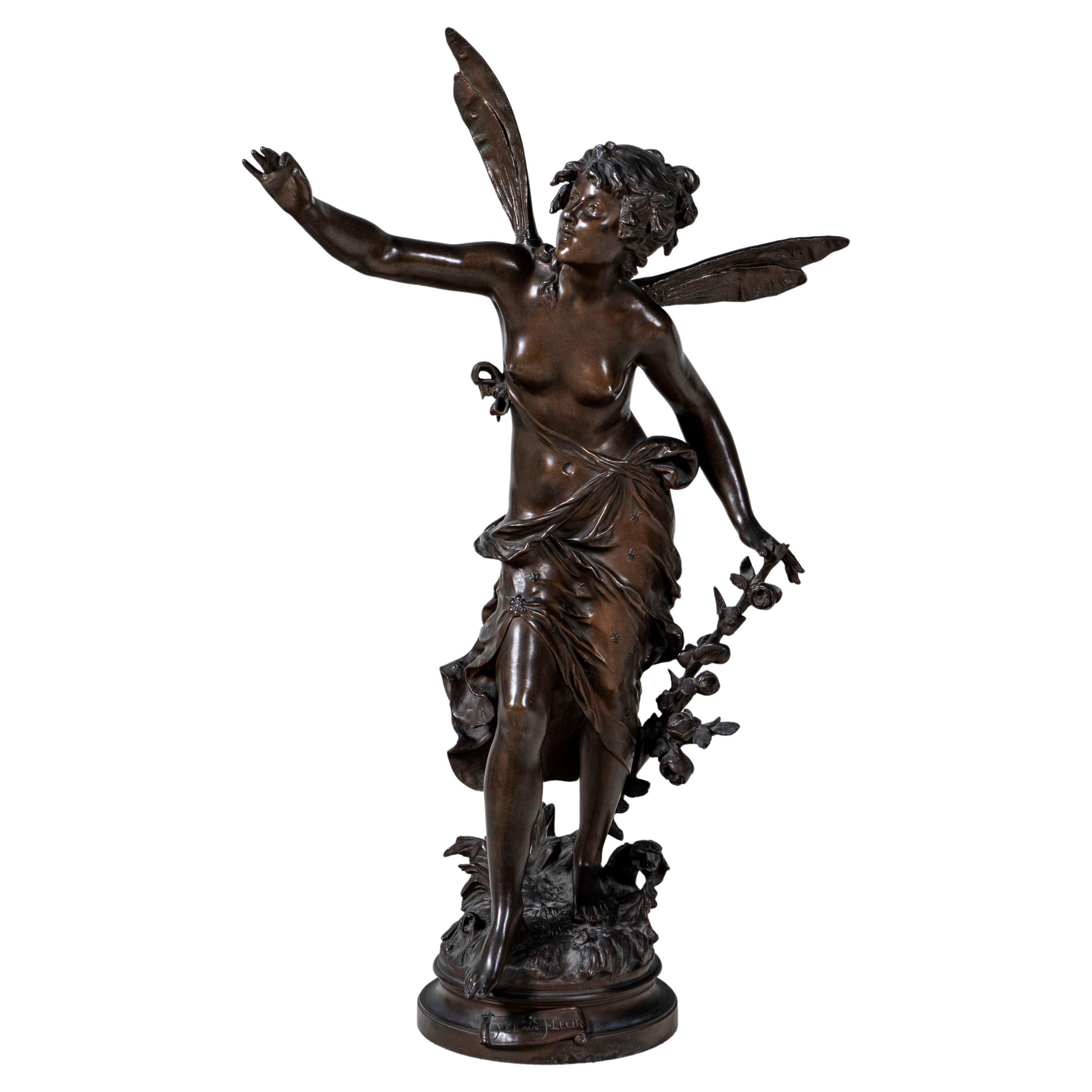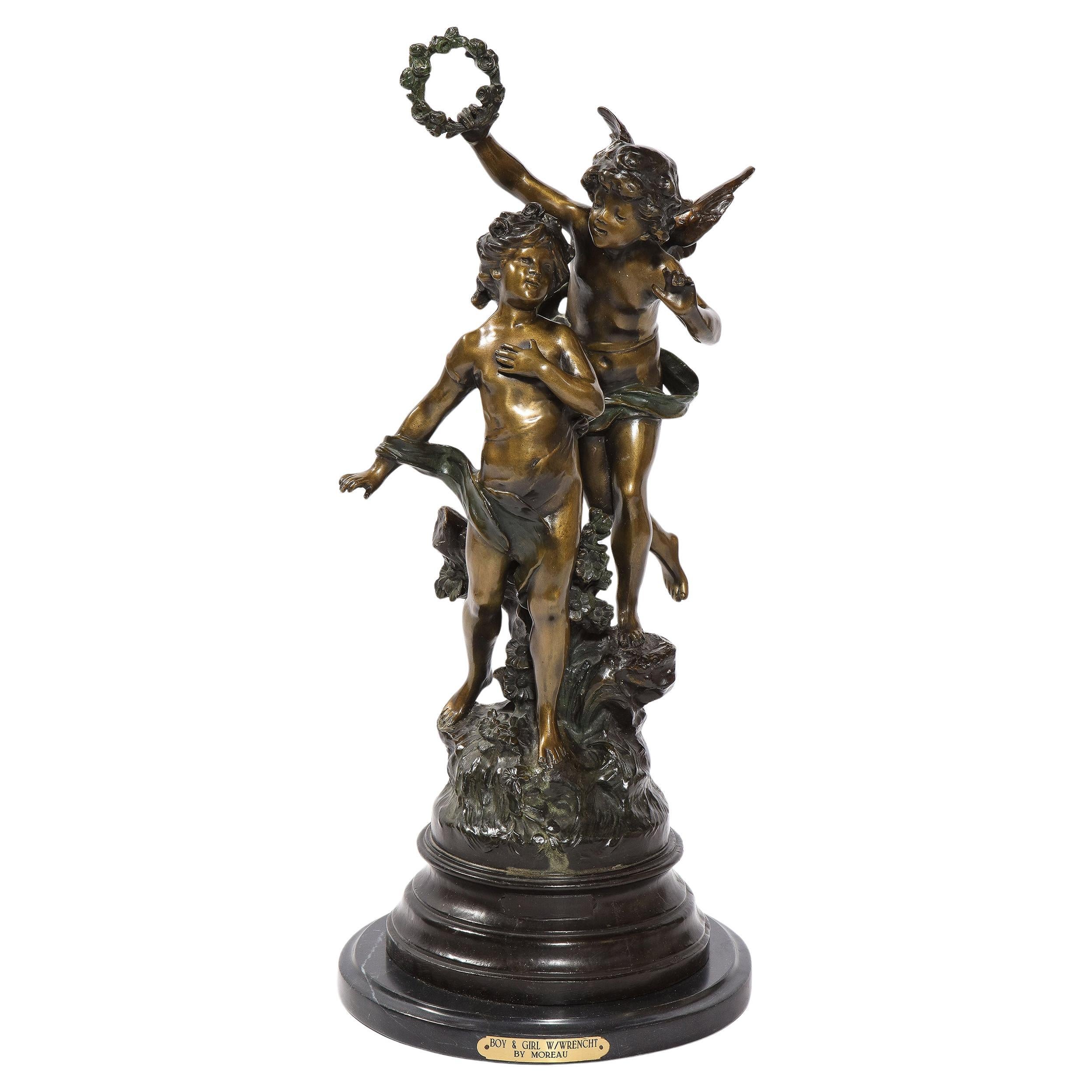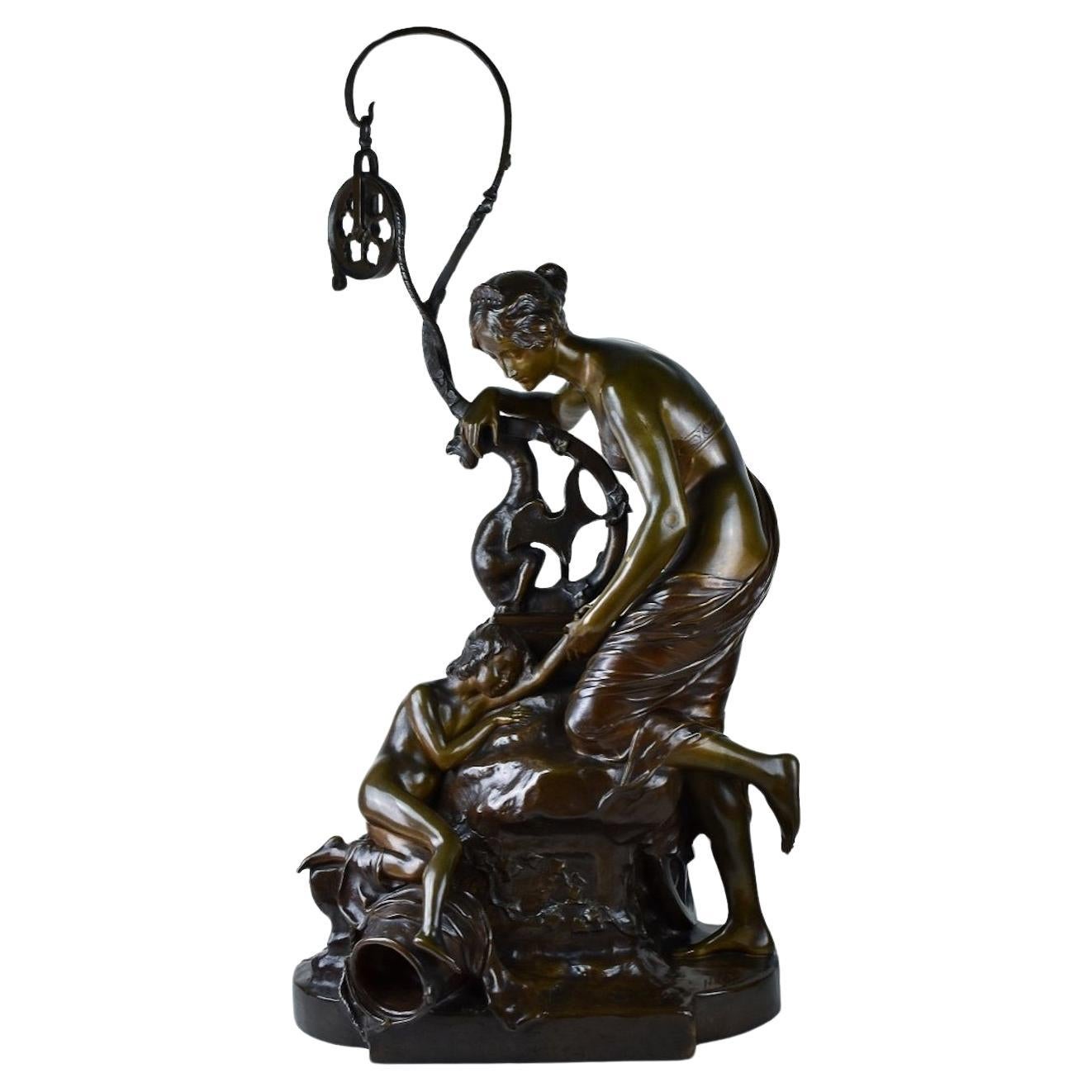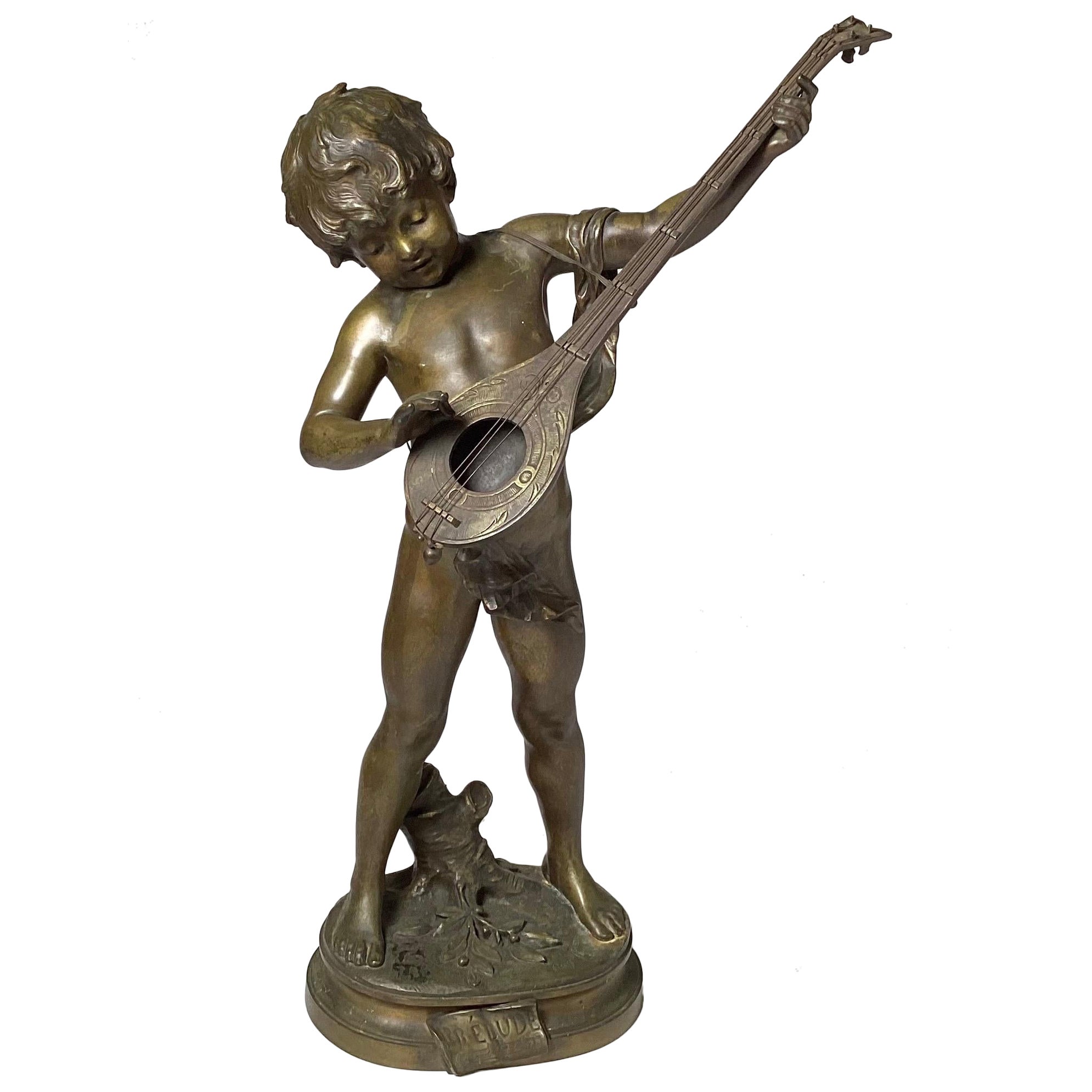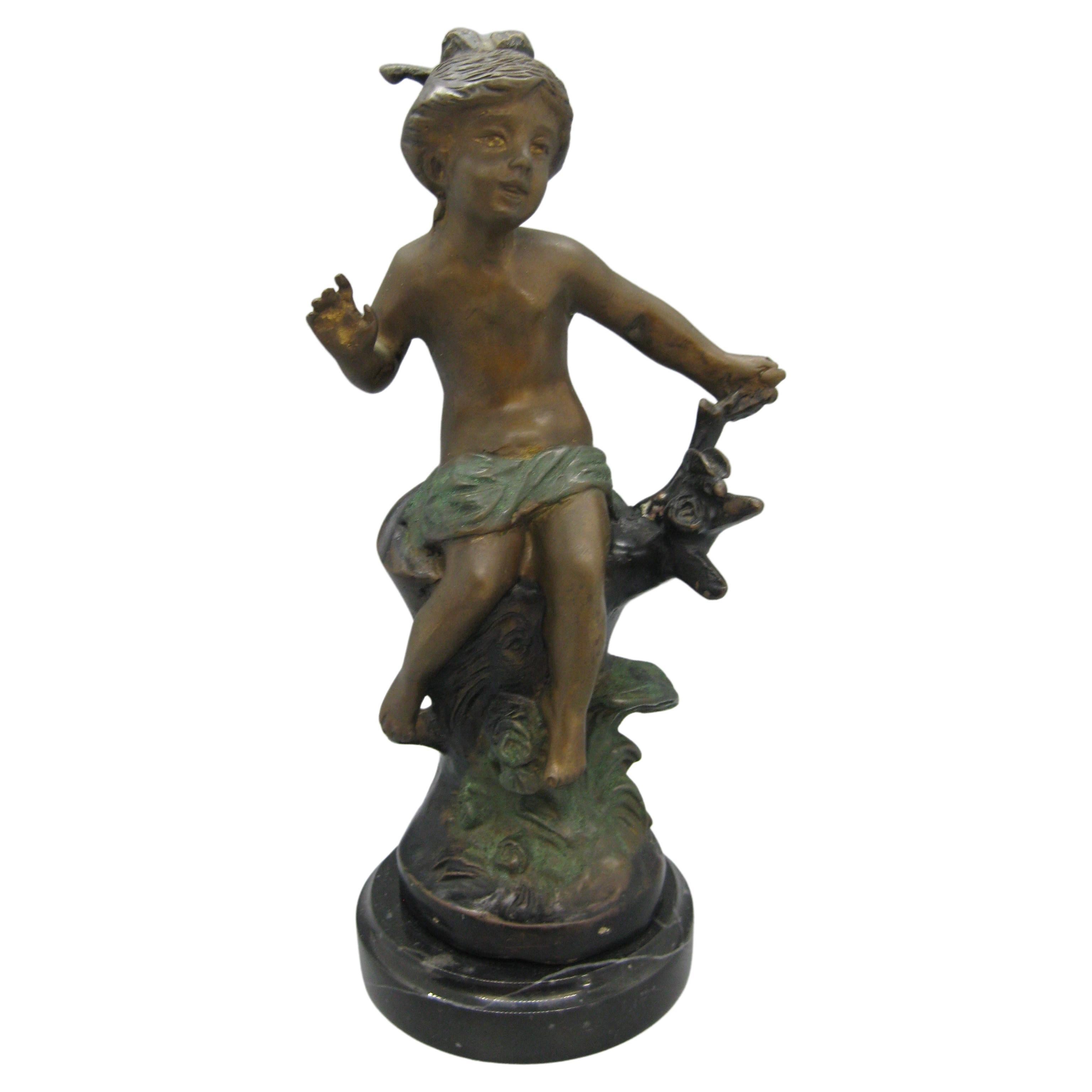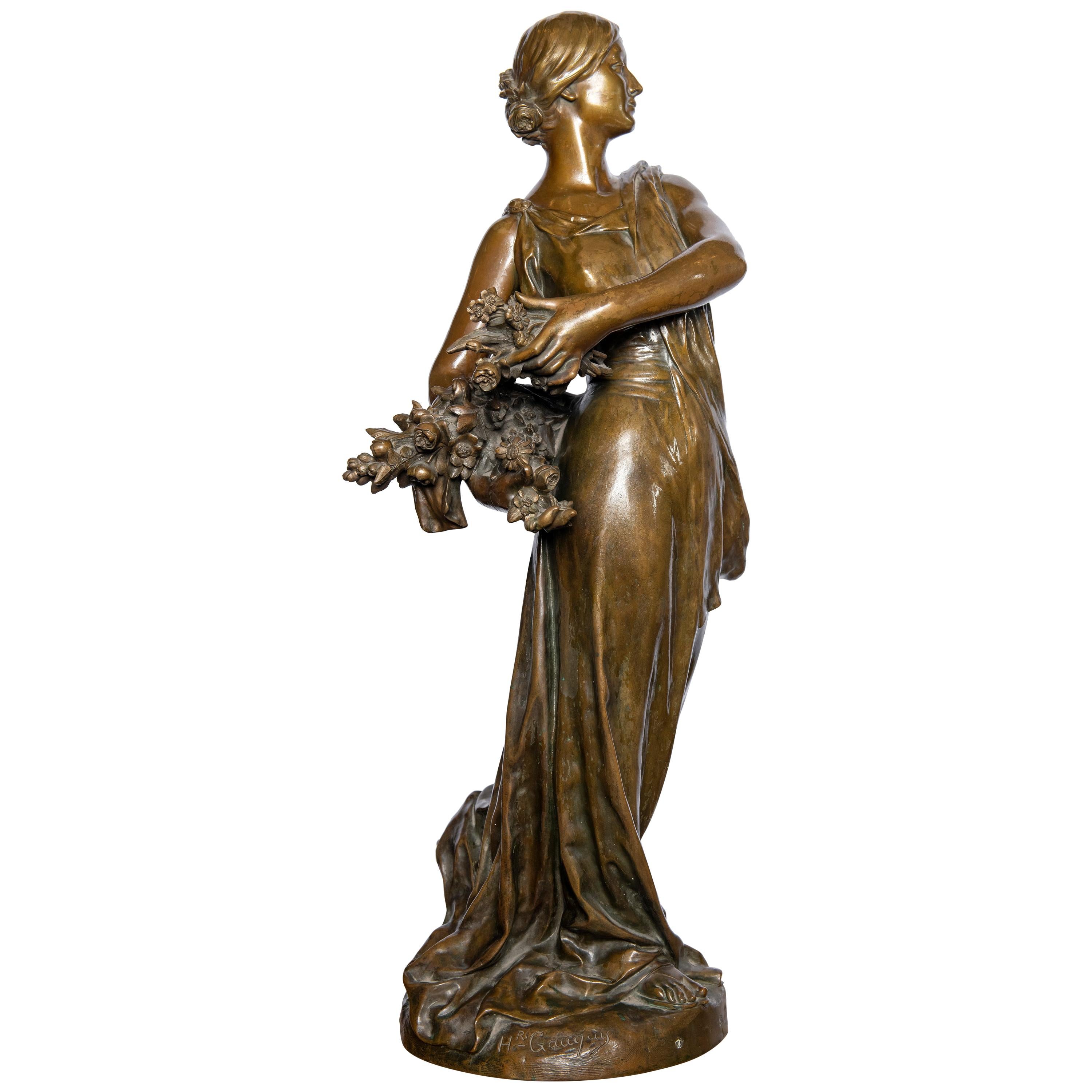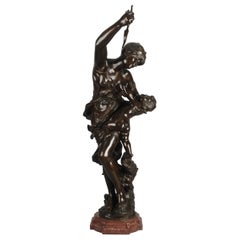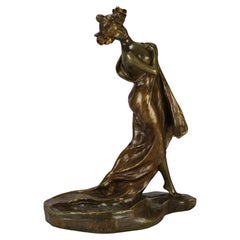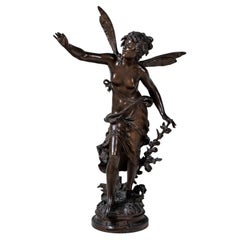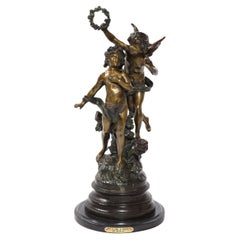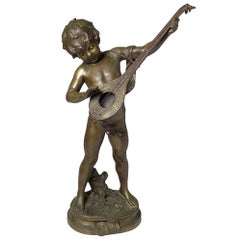Items Similar to 19th Century Art Nouveau Bronze Sculpture "Fille au Puits" by Auguste Moreau
Want more images or videos?
Request additional images or videos from the seller
1 of 12
19th Century Art Nouveau Bronze Sculpture "Fille au Puits" by Auguste Moreau
$3,529.19
£2,550
€3,015.38
CA$4,830.69
A$5,410.62
CHF 2,815.33
MX$65,711.66
NOK 35,691.20
SEK 33,677.31
DKK 22,499.05
Shipping
Retrieving quote...The 1stDibs Promise:
Authenticity Guarantee,
Money-Back Guarantee,
24-Hour Cancellation
About the Item
A very fine late 19th Century Art Nouveau bronze figure of a young girl sat upon a well feeding a small bird, exhibting excellent rich brown variegated patina and very fine hand finished surface detail, signed A Moreau & stamped Societe des Bronzes
ADDITIONAL INFORMATION
Height: 22.5 cm
Width: 14 cm
Depth: 11 cm
Condition: Excellent Condition
Circa: 1890
Materials: Bronze
Book Ref: Bronzes of 19th Century
Page No: 505
SKU: 9127
ABOUT
Auguste Moreau
Auguste Moreau (born 22 February 1834 in Dijon , the death 11 November 1917 in Malesherbes) was a French sculptor. The third son of sculptor and painter Jean Baptiste Moreau and the younger brother of sculptor Hippolyte Moreau and Mathurin Moreau, Auguste initiated himself to sculpture along with his older brother Mathurin. His subjects were primarily genre scenes, pastorals, and allegories; his style was realistic and graceful, revealing his relation to the other members of the Moreau dynasty. The similitude of names sometimes provokes confusion in the attribution of certain works signed without first initials.
The artist was taught by his father and was introduced by him in the craftwork of sculpture. We can assume that he continued his education at one of the popular art schools in the French capitol. In his early life Auguste Moreau visited the "École des Beaux-Arts". Since 1968 this famous academy has been called "École nationale supérieure des beaux-arts". It was founded on April 20, 1797 as, École spéciale de peinture, de sculpture et d`architecture" and was officially acknowledged by the French King Louis XVIII in 1819. The most renowned schools are located in the district Saint-Germain-des-Prés and extends over an area of approximately 2 hectare. In the past there was the Augustinian monastery "couvent des Saints-Augustins" at this location. Even today its little chapel is preserved. The studies at the academy are always held in studios. He probably knew few of the famous artists, who graduated at the "École des Beaux-Arts". Among them are Henri Matisse and the carver Georges Gimel.
Auguste Moreau even developed a special style of filigree figures during his further artistic training and development. His works were first exhibited in 1861; therefore he became well-known very early. In the 19th century the French capitol had several locations of famous and great world`s fairs, at which also artists showed and presented their works. With the help of these exhibitions a lot of Moreau`s colleagues became famous and we can assume that he himself knew them and associated with them. The first French world`s fair was held in 1855. For the first time there was a stage for the contemporary and modern artistic trends and a special pavilion, the "Palais des Beaux-Arts", was built for that. Additional world`s fairs took place in 1867, 1878 and 1889. The reason for the fair in 1889 was the famous Eiffel Tower had been built. It still exists and became the international symbol of Paris.
The smaller world exhibition "Exposition internationale des Arts Décoratifs et industriels modernes" took place in 1925 and was dedicated to arts and crafts and industrial design. The exhibition became a great stage for the international avant-garde of the modern and fine arts and therefore the artistic trend Art deco is named after it. Auguste Moreau had points of contact with the arts décoratifs, but he was more interested in the Art Nouveau. He became an important representative of this artistic trend that is marked by its floral motifs and ornaments, curved lines and the demand to melt life together with art. Auguste Moreau worked in this style, designing filigree sculptures, figures and busts that seem very naturally and detailed. The extraordinary artist died in 1917.
- Creator:Auguste Moreau (Artist)
- Dimensions:Height: 8.86 in (22.5 cm)Width: 5.52 in (14 cm)Depth: 4.34 in (11 cm)
- Style:Art Nouveau (Of the Period)
- Materials and Techniques:Bronze,Cast
- Place of Origin:
- Period:
- Date of Manufacture:1890
- Condition:Wear consistent with age and use.
- Seller Location:London, GB
- Reference Number:Seller: 91271stDibs: LU3216339135842
About the Seller
5.0
Gold Seller
Premium sellers maintaining a 4.3+ rating and 24-hour response times
Established in 1936
1stDibs seller since 2017
80 sales on 1stDibs
Typical response time: 3 hours
- ShippingRetrieving quote...Shipping from: London, United Kingdom
- Return Policy
Authenticity Guarantee
In the unlikely event there’s an issue with an item’s authenticity, contact us within 1 year for a full refund. DetailsMoney-Back Guarantee
If your item is not as described, is damaged in transit, or does not arrive, contact us within 7 days for a full refund. Details24-Hour Cancellation
You have a 24-hour grace period in which to reconsider your purchase, with no questions asked.Vetted Professional Sellers
Our world-class sellers must adhere to strict standards for service and quality, maintaining the integrity of our listings.Price-Match Guarantee
If you find that a seller listed the same item for a lower price elsewhere, we’ll match it.Trusted Global Delivery
Our best-in-class carrier network provides specialized shipping options worldwide, including custom delivery.More From This Seller
View All19th Century Art Nouveau Bronze Entitled "Venus & Cupid" by Jean Sul-Abadie
By Jean Abadie
Located in London, GB
A very fine bronze study of Venus taking an arrow from Cupid her son, who at times would shoot his arrows without meaning or reason into the hearts of men, igniting their desire. Exhibiting excellent rich brown patina and good detail, signed Sul Abadie and stamped.
Additional information
Height: 93 cm
Condition: excellent condition
Circa: 1885
Materials: bronze & marble
SKU: 4979
ABOUT
Jean Sul-Abadie
Jean Sul-Abadie (Born 1850 ~ Died 15th April 1890) was a French artist, a pupil of Jouffroy and Falguière. Specialising in bronze sculpting in the Art Nouveau style. He made his Salon debut in 1872.
Cupid & Venus
Different tales exist about the origin of Venus and Cupid. Some say that Venus, the goddess of love and beauty, had a love affair with Mars, the god of war. Out of this relationship, Cupid was born. In the following painting you see Venus with Mars, who is being disarmed by Cupid.
Cupid has attributes from both of his parents. Like his mother he is considered to be the god of love, or more precisely, the god of falling in love. He is portrayed as an innocent little child with bow and arrows. He shoots arrows to the heart, and awakening a love that you’re powerless to resist.
In classical mythology, Cupid (Latin Cupido, meaning “desire”) is the god of desire, erotic love, attraction and affection. He is often portrayed as the son of the love goddess Venus and the war god Mars, and is known in Latin also as Amor (“Love”). His Greek counterpart is Eros.
Although Eros is in Classical Greek art as a slender winged youth, during the Hellenistic period, he was increasingly portrayed as a chubby boy. During this time, his iconography acquired the bow and arrow that represent his source of power: a person, or even a deity, who is shot by Cupid’s arrow is filled with uncontrollable desire. In myths, Cupid is a minor character who serves mostly to set the plot in motion. He is a main character only in the tale of Cupid and Psyche, when wounded by his own weapons he experiences the ordeal of love. Although other extended stories are not told about him, his tradition is rich in poetic themes and visual scenarios, such as “Love conquers all” and the retaliatory punishment or torture of Cupid.
In art, Cupid often appears in multiples as the Amores, or amoriniin the later terminology of art history, the equivalent of the Greek erotes. Cupids are a frequent motif of both Roman art and later Western art of the classical tradition. In the 15th century, the iconography of Cupid starts to become indistinguishable from the putto.
Cupid continued to be a popular figure in the Middle Ages, when under Christian influence he often had a dual nature as Heavenly and Earthly love. In the Renaissance, a renewed interest in classical philosophy endowed him with complex allegorical meanings. In contemporary popular culture, Cupid is shown drawing his bow to inspire romantic love, often as an icon of Valentine’s Day.
Venus is the Roman goddess whose functions encompassed love, beauty, sex, fertility, prosperity, victory, and desire. In Roman mythology, she was the mother of the Roman people through her son, Aeneas, who survived the fall of Troy...
Category
Antique Late 19th Century French Art Nouveau Figurative Sculptures
Materials
Breccia Marble, Bronze
Early 20th Century Art Nouveau Bronze Entitled "La Jeuneuse" by Antonin Carlès
By Antonin Carlès
Located in London, GB
A delightful Art Nouveau early 20th Century gilt bronze figure of a very beautiful young lady holding a flower in her right hand, the surface of the bronze exhibiting fine detail and...
Category
Antique Early 1900s French Art Nouveau Figurative Sculptures
Materials
Bronze
Late 19th Century Bronze Entitled 'La Verité Meconnue' by Aime-Jules Dalou
By Aimé-Jules Dalou
Located in London, GB
An enigmatic late 19th Century bronze study of a seated female nude leaning on her knees, hiding her face, on integral naturalistic canted rectangular base, signed to one side DALOU above the cracked mirror (facing to the rear), the opposing side marked Susse Fres Edts the rear with Susse Freres pastille flanked by the letters H P and S.
The title of this subject translates as 'The Truth Revealed' and refers to the young woman inconsolable having seen her true reflection in a mirror, which she has dropped and lies broken on the hard floor.
ADDITIONAL INFORMATION
Height: 14 cm
Width: 12 cm
Depth: 8 cm
Condition: Excellent Original Condition
Circa: 1890
Foundry: Susse Frères Paris
Materials: Bronze
SKU: 8790
ABOUT
Aimé-Jules Dalou...
Category
Antique 19th Century French Art Nouveau Figurative Sculptures
Materials
Bronze
Late 19th Century Art Nouveau Bronze "Nouveau Lady" by Georges Van Der Straeten
By Georges Van der Straeten
Located in London, GB
A delightful Art Nouveau Bronze figure of a young beauty scantily dressed with only a shawl draped across her body in a striking pose. The surface of the bronze with rich golden/brow...
Category
Antique Late 19th Century Belgian Art Nouveau Figurative Sculptures
Materials
Bronze
Late 19th Century Art Nouveau Bronze figure "Slave Girl" by Emmanuel Villanis
By Emmanuel Villanis
Located in London, GB
A beautiful patinated Art Nouveau bronze study of a young Art Nouveau beauty sat upon a wall wearing chains with excellent variegated rich brown patina and excellent hand chased surf...
Category
Antique Late 19th Century French Art Nouveau Figurative Sculptures
Materials
Bronze
Late 19th Century Art Nouveau French Bronze entitled "Boy and Girl"
Located in London, GB
A charming pair of late 19th Century bronze studies of a two young children one holding a bowl whilst the other holds a bird with excellent hand chased surface detail and very fine r...
Category
Antique Late 19th Century French Art Nouveau Figurative Sculptures
Materials
Bronze
You May Also Like
Bronze Alloy Sculpture, Signed L. Moreau, France, Late 19th Century
By Louis Auguste Moreau
Located in Buenos Aires, Buenos Aires
Bronze Alloy sculpture "Fée Aux Fleurs", Signed L. Moreau, France, Late 19th Century.
Category
Antique Late 19th Century French Art Nouveau Figurative Sculptures
Materials
Bronze
Fine Patinated Bronze Sculpture by Auguste Moreau
By Auguste Moreau
Located in Lyndhurst, NJ
The two patina bronze sculpture by Auguste Moreau showing a winged boy with another child. Set on a stepped black marble base.
Signed AUG. Moreau in the casting.
Auguste was the thi...
Category
Antique Late 19th Century French Belle Époque Figurative Sculptures
Materials
Bronze
Large Sculpture in Patinated Bronze by Henri Vidal, Circa 1900, Art Nouveau.
Located in Saint-Ouen, FR
Large sculpture in patinated bronze by Henri Vidal, circa 1900, Art Nouveau period.
Patinated bronze sculpture by the sculptor Henri Vidal, Art Nouveau period, circa 1900.
H: 100cm,...
Category
20th Century French Art Nouveau Figurative Sculptures
Materials
Bronze
An Antique French Bronze signed Auguste Moreau, Late 19th Century
By Auguste Moreau
Located in Lambertville, NJ
A late 19th Century Art Nouveau patinated bronze sculpture of a young boy with instrument. Artist signed Auguste Morea, with the French bronze hallmark on base. 24 inches tall
Category
Antique 1890s Art Nouveau Figurative Sculptures
Materials
Bronze
Art Nouveau French Bronze with Enamel Paint Child Sculpture by Auguste Moreau
By Auguste Moreau
Located in San Diego, CA
Beautiful Art Nouveau bronze sculpture by French artist Auguste Moreno. The sculpture is made of bronze with enamel painted accents. Signed on the back. Attached to a marble base. In...
Category
Early 20th Century French Figurative Sculptures
Materials
Bronze
Bronze Sculpture Signed H. Gauquie, France, Late 19th Century
By Henri Desire Gauquie
Located in Buenos Aires, Buenos Aires
Bronze sculpture signed H. Gauquie, France, late 19th century.
Category
Antique Late 19th Century French Art Nouveau Figurative Sculptures
Materials
Bronze
$11,200 Sale Price
20% Off
More Ways To Browse
Germain Bronze
French Monastery
Gold Eiffel Tower
Book Tower
Matisse Book
Moreau Girl
Bronze Hippolyte Moreau
Moreau Girl Sculpture
Eiffel Tower Sculpture
Jean Baptiste Germain Bronze
Art Deco Goldscheider Figurines
Glass Clowns
Pre Columbian Figure
Wood Buddhas
Alabaster Woman
Antique Mandolin
Antique Wax Portrait
Art Deco Marble Statues
